

We’ve rebranded to reflect who we’ve become: a science-based, privacy-focused proctoring platform designed for modern education, certification, and workforce assessments. OctoProctor represents our commitment to smarter, more adaptable, and test-taker-friendly remote proctoring.
Academic dishonesty and cognitive offloading are mounting challenges in the age of AI. The good news? Integrating AI literacy and AI in assessment may help.
The best inoculation against today’s AI cheating epidemic is AI in assessment. We analyze the AI cheating landscape and discuss the opportunities and challenges of AI-powered proctoring. Finally, we look ahead to AI literacy for long-term student success.
There’s no getting around it: AI is now part of the modern learner’s toolkit, with 90% of students using it for academic purposes today.
So why is everybody freaking out about student AI use?
New York Magazine has suggested that young people are cheating their way through college using tools like ChatGPT. Yet, the AI cheating epidemic — as it’s been coined — is much more complex than meets the eye.
After all, 55% of teachers believe AI has improved educational outcomes in the classroom. New studies report advantages of AI in learning contexts, such as personalized support, chatbots as tutors and more.
That’s why the question of academic integrity and AI is so urgent. Let’s take a deep dive into how AI is redefining education — and how AI literacy and AI in assessment may provide the much-needed balance to nurture real student learning.
Education has always been impacted by technological advancements — think overhead projectors, Scantron testing and the internet.
Yet, we got a crash course in digital transformation in education when COVID-19 broke out in 2020, forcing schools to set up remote learning environments overnight. During this adoption phase, teachers leaned on tools such as educational apps, mobile games and more.
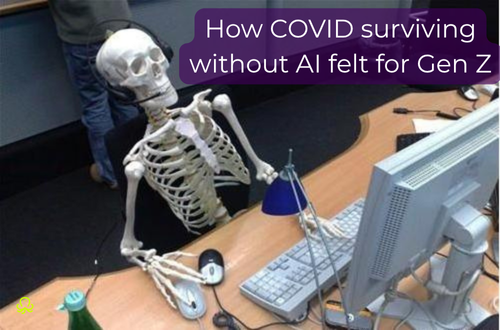
Now, AI is changing the classroom at warp speed. Since ChatGPT’s advent in 2023, teachers are adapting to student AI use — and misuse. AI is influencing learning as students prepare for exams, write essays and complete assignments. Teachers are also getting on board, using it for lesson planning, grading and assessment.
But the evolution of online learning doesn’t stop here. Stanford scholars believe that AI is only the beginning. Some new technologies waiting in the wings include immersive environments, student data-gathering and more.
ChatGPT isn't the only AI tool on the block. AI has a range of capabilities and applications -— some more obvious than others.
For example, AI doesn’t just not generate essays or solve math problems. It’s also the foundational technology for virtual assistants, facial recognition, product recommendations and more.
What do these types of AI have in common? The ability to mimic human-level task completion based on vast amounts of training data.
Artificial intelligence doesn’t think up its own solutions. It simply “predicts” what a good solution might be based on its training data and model design. There’s no consciousness, emotion or creativity involved. Everything it comes up with originates in data from humans.
In this same vein, AI isn’t a knowledge base. The well-documented problem of AI hallucinations stems from its predictive qualities. These models imitate how a human would talk or solve a problem — they can’t actually engage in new thinking or research.
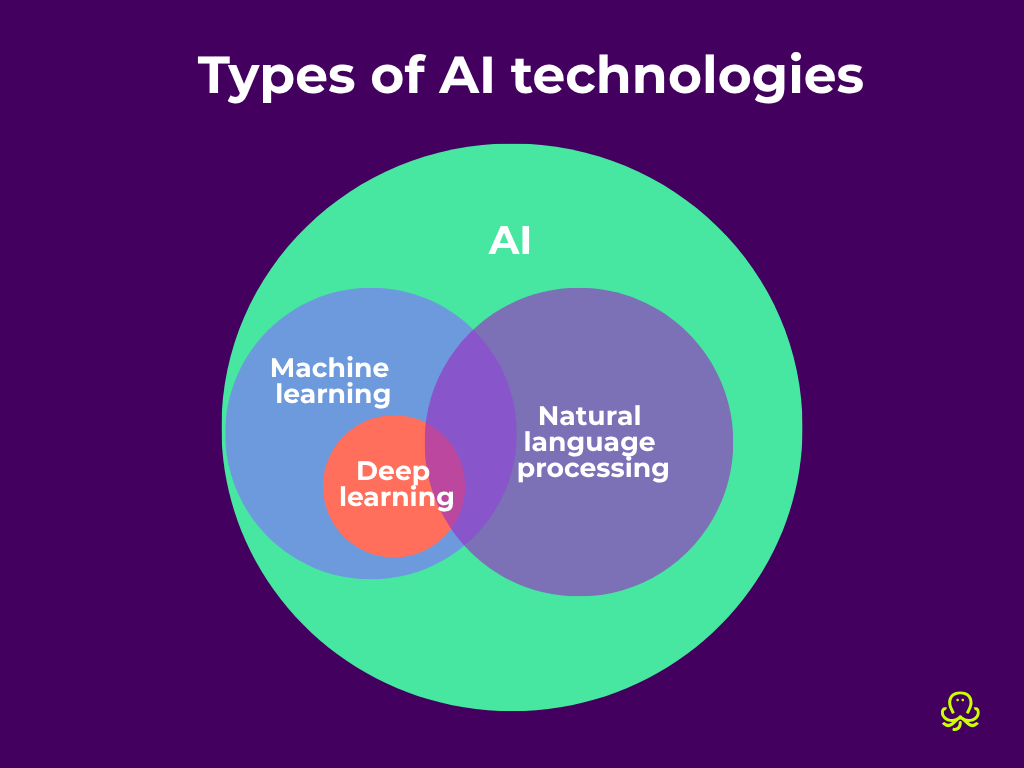
Let’s explore the main AI technologies to get a better grasp of their distinctions and applications in education.
Machine learning is an AI system known for its ability to keep learning in the long run without hard-coded instructions.
Examples: Fraud detection, recommendation systems, traffic predictions, etc.
Deep learning is a subset of machine learning that uses artificial neural networks to process very large, complex and unstructured data sets.
Examples: Voice-activated assistants, predictive analysis, driverless cars, etc.
Computer vision systems can process and analyze highly complex visual information, such as images and videos.
Examples: Facial recognition, medical imaging, smart manufacturing, etc.
NLPs is a type of machine learning dedicated to understanding and using human language. With it, machines are able to process requests and generate responses.
Examples: Chatbots, personalized marketing, machine translation, etc.
Generative AI is a specialized area of NLPs focused on creating human-like content including text, images and other multimedia.
Examples: Content creation, multimedia creation, code generation, etc.

Let’s be honest: there’s a lot that AI can’t do in the learning context. AI can’t think critically. It can’t research reputable sources. And it certainly lacks the creative hallmark of human-made work.
Even so, this doesn’t mean AI is worthless in the classroom. Let’s discuss some popular use cases of AI for teachers and students.
43% of teachers are using AI to create adaptive learning systems that tailor experiences to specific student needs. For example, AI can auto-customize educational activities and pacing according to a learner’s ideal parameters.
Integrating AI-based educational games is becoming popular as well via apps such as Minecraft, Kahoot! and Osmo.
AI in learning also supports more administrative tasks at educational institutions, i.e. course information, campus event reminders, etc.
AI has become a go-to homework helper. Students can ask AI to answer questions, drill content, research topics and more.
Teachers are saving hours in grading by using AI, with 49% reporting positive impacts on their workloads. Yet, the jury’s still out on AI grading, as it may generate inaccurate or biased feedback — not to mention the lack of nuance and personalization.
New tools can detect AI content in essays or solutions, allowing teachers to identify plagiarism. Depending on the tool, accuracy may be hit or miss — with most scoring below 80% in accuracy according to a recent study.
It’s not just schools that are incorporating AI in learning. Businesses that host safety, HR or compliance training can use AI to create course materials and score employee results.
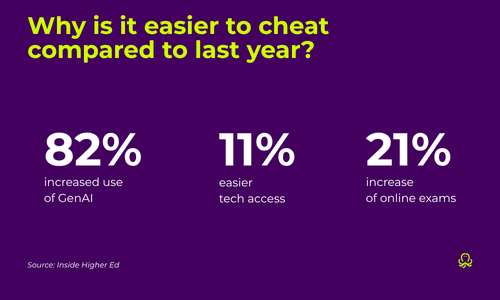
Cheating is hardly a new phenomenon, though tools like ChatGPT have made it more tempting. Today, 44.7% of students admit to cheating during an online exam, often by using chatbots to generate essays, answers, translations or code snippets.
And it’s happening all over the world. In the UK alone, there were 7,000 proven cases of AI cheating in higher education last year. This is just the start, with both teachers and students expecting higher levels of cheating in the next three years.
Most importantly, the use of AI may be more detrimental to learners today than SparkNotes ever was — here’s why.
A famous MIT study suggests that users of LLMs showed a 47% decline in brain activity. Overall, studies on cognitive atrophy due to AI report decreases in critical thinking, analytical thinking, decision-making and creativity.
New studies suggest that users who over-rely on AI are more susceptible to misinformation. They may accept AI-generated errors without thoughtful analysis and research.
Students who offload their thinking to an AI tool may not fully learn important academic skills (writing, researching, coding, etc.). As a result, they may be more dependent on technology and gain fewer “foundation skills.”
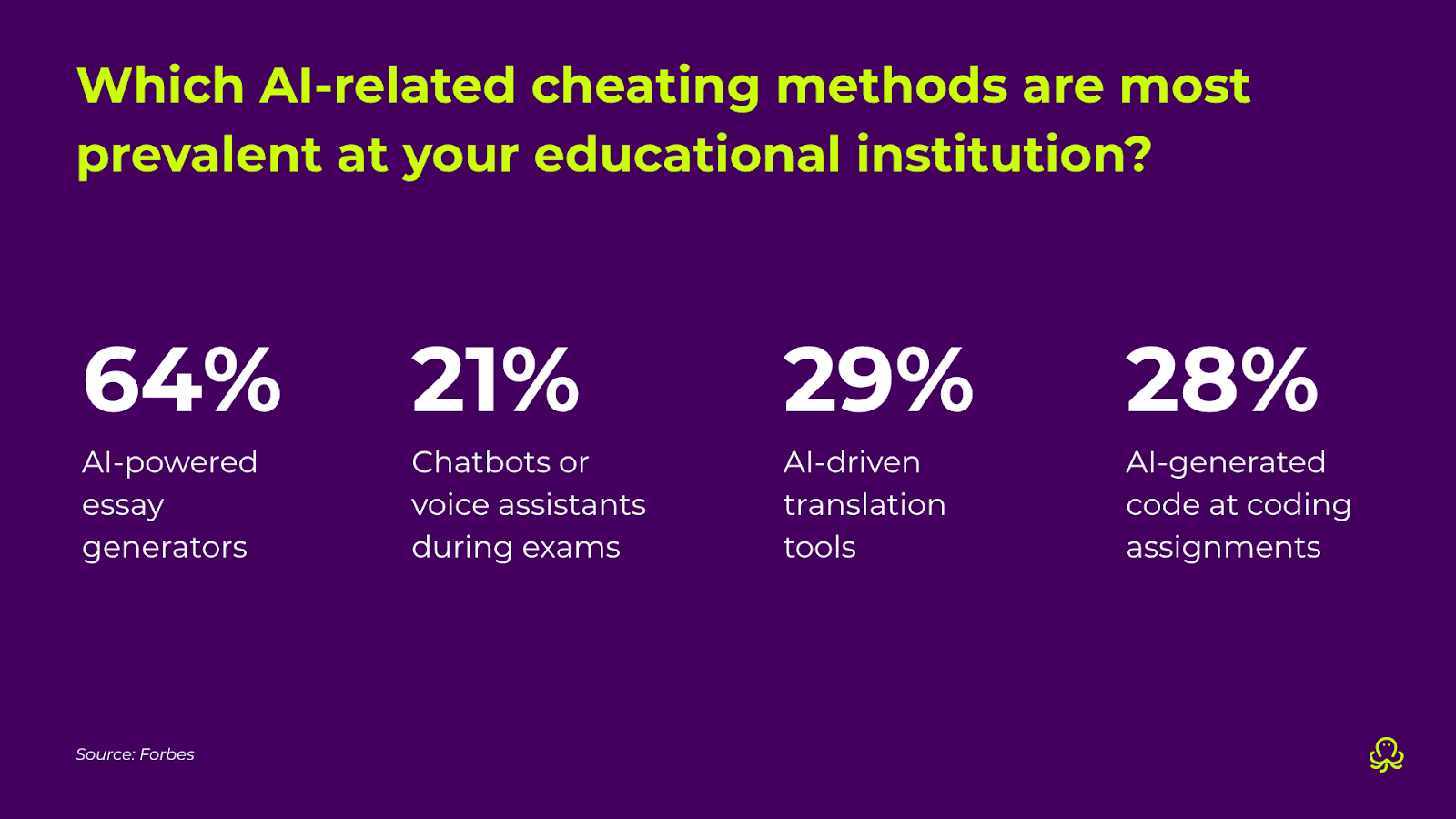
Academic integrity in the age of AI starts with teachers rethinking how they evaluate work. Luckily, stronger exam design can make a big impact in AI cheating detection. Plus, AI-safe assessment design may help encourage real learning.
Blue books are having a comeback, with sales up by 80% at some university stores. That’s because teachers are getting around AI cheating by designing tests that require handwritten answers in in-person settings. They’re also making up prompts to encourage students to write about their own lives or requiring them to present their findings live for deeper engagement.
For online classrooms, in-person or tech-less exams just aren’t possible. That’s where AI in assessment (i.e. remote proctoring) can make the testing process as fair as possible. This type of proctoring — whether live, automated or AI based — identifies unauthorized use of tools, checks student IDs and keeps the exam secure.
Unfortunately, academic dishonesty today can be difficult to detect without the right technologies. As a result, universities, businesses and accreditation bodies are turning to online proctoring to reduce the risks of AI in learning:
Overall, AI in certification enables automated monitoring and flags unauthorized use of tools in real-time.
As any classroom tool, AI in assessment should be implemented thoughtfully. While AI offers efficiency for increasingly complex testing, it’s not without flaws.
Accuracy in detecting cheating is essential — both in flagging incidents and avoiding false positives. 68% of teachers are using these tools today, making the quality of results a must.
AI has well-studied biases arising from flawed data or algorithm design. AI detection tools are especially skewed against students with disabilities and non-English speakers.
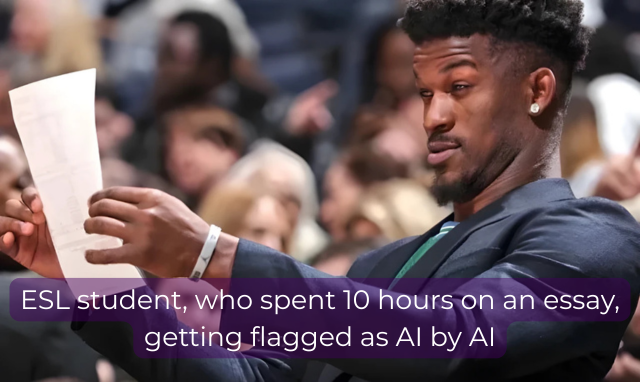
Student data is highly sensitive, making online learning security paramount in cheating prevention with AI.
Not all students will have technology and internet available at home for online testing. For full equity, organizations should look ahead to cover any equipment gaps.
For students, AI in education can be a double-edged sword. Studies show that a balanced approach to AI has positive outcomes for learners. On the flip side, overreliance on AI has some worrying psychological effects.
Overreliance on AI also can impact student well-being. By depending on AI for every academic task — instead of working with peers or asking the teacher — students may struggle with social isolation. They may also feel academic anxiety stemming from not understanding the material and feeling pressured to find shortcuts.
62% of teachers worry about AI downplaying human interaction in learning environments. A major risk of overreliance on AI is weakening classroom relationships and social-emotional intelligence.
Educators may also face negative impacts after using AI to grade work, as it can erode trust with students. As one student summed up, “How can a heartless robot grade a student’s real, genuine work?”
Employers today are looking for candidates with strong AI skills. Yet, students who get used to outsourcing their thinking with AI may struggle on the job with cognitive tasks, such as working independently and coming up with original ideas.
The World Economic Forum has now listed AI literacy as a “core competency” for education. Basically, AI literacy is aimed at teaching how to use these tools effectively, as well evaluate their limitations and risks.
Educators at Stanford University have compared AI literacy with driver’s ed as a way to keep AI usage safe and effective. Additionally, organizations such as TeachAI and UNESCO have put out human-centered best practices to model responsible AI use in education.
It’s never too early to kick off the AI conversation. Try out some age-tailored activities for kids in elementary school.
Students should avoid taking AI-generated content at face value. Instill healthy skepticism in students so they ask where the information came from, how to evaluate it for accuracy, etc.
AI goes beyond the technology and computer science fields. Have students explore AI’s influence in other subjects, such as design, social media, finance and more.

AI is a minefield of ethical issues — from thorny copyright and privacy to misinformation and eco-unfriendly data centers. Teach your students solid digital citizenship by discussing these areas of concern.
Finally, AI is just one of many learning tools. Equip learners with effective and reputable resources to support their assignments beyond AI.
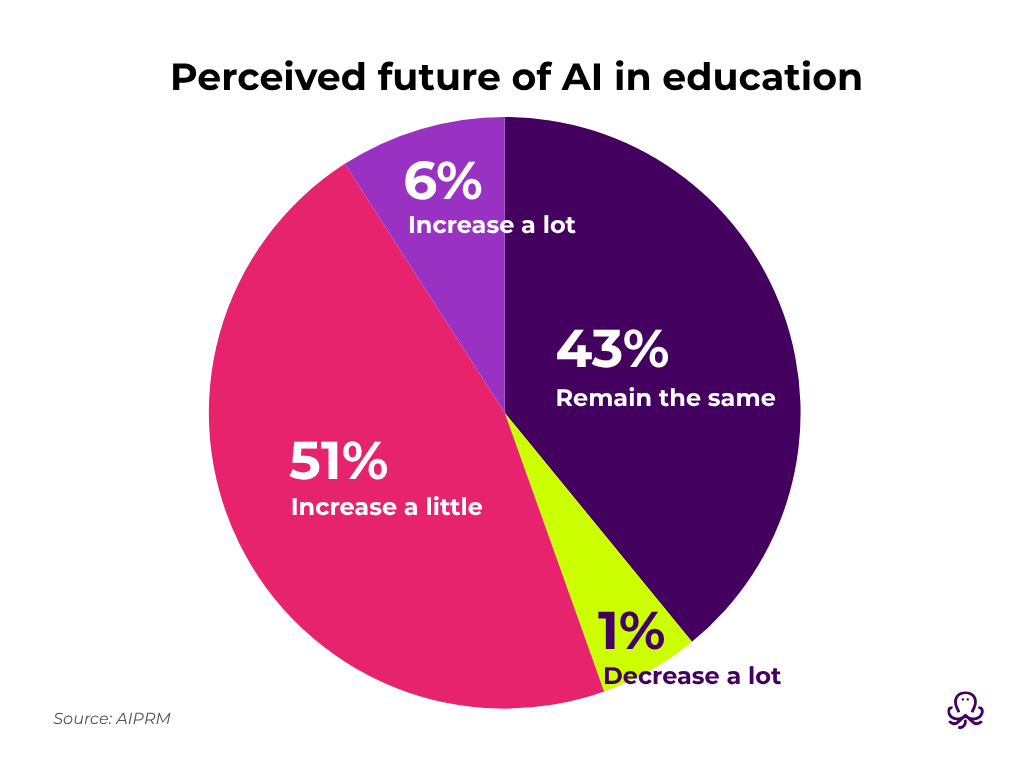
The future of AI in education is “just getting started.” Like any learning tool, it has its advantages and disadvantages — mainly academic dishonesty, inaccuracy, bias and lack of privacy.
Fortunately, your organization can better uphold the ethics of AI in education by understanding that:
By addressing these key issues, your students can get back to learning — instead of gaming the test.
See how we’re setting the bar high for AI proctoring at OctoProctor.
A degree alone no longer guarantees long-term employment. Reskilling and upskilling through flexible learning help workers stay relevant in their roles, while organizations can trust the verified credentials employees earn.
More OctoProctor teammates share how discipline, joy, empathy, and cooking rituals help them stay balanced, energized, and creative.